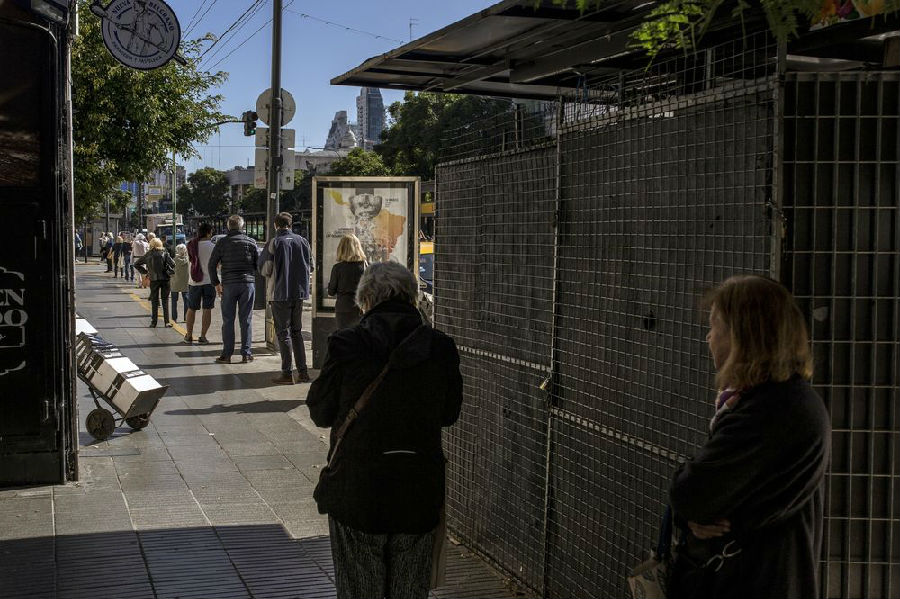Where covid-19 strikes, it reveals hard truths.
新型冠状病毒肺炎所到之处,揭示了残酷的事实。
In recent weeks Latin America has become the centre of the pandemic, responsible for over half of daily deaths.
在近几周,拉丁美洲成为了疫情的中心,一半以上的每日死亡人数都来自这里。
The region's acute health crisis is accompanied by an economic decline unrivalled in the developing world.
该地区严重的健康危机还伴随着一场发展中世界的其他国家所无法比拟的经济衰退。
The IMF forecasts that output in the region will shrink by 9.4% in 2020,
国际货币基金组织(IMF)预测,2020年,该地区的产出将萎缩9.4%,
more than three times the contraction of 3% projected for emerging economies as a whole.
是整个新兴经济预测收缩的三倍多。
The economic and social devastation wreaked by the pandemic is all the more painful for coming on the heels of two underwhelming decades.
在未来普通的20年里,疫情所造成的经济和社会灾难更加痛苦。
Investors had waxed enthusiastic about Latin America's prospects
在2000年到2019年的新兴市场繁荣时期,
during the great emerging-market boom of the 2000s and the 2010s, only to be disappointed.
投资者曾对拉丁美洲的前景充满热情,而现在只剩失望。
The few gains that were made seem almost certain to be reversed. The economies of Latin America are far from homogeneous.
取得的少数进展似乎肯定会逆转。拉美国家的经济体远达不到同质化。
Many share characteristics, however, that have conspired to make the region among the hardest hit in the world.
然而,很多这些共同的特点使该地区成为全球受创最严重的地区之一。
In some places lockdowns have been stringent:
在一些地方,封锁一直很严格:

Peru, for example, took the extraordinary step of closing its mines, the foundation of its economy,
例如,秘鲁采取了不同寻常的措施,关闭了作为其经济基础的矿山,
contributing to the IMF's grim forecast of a decline in output of 14% this year.
导致IMF做出了其今年产出下降14%的悲观预测。
But big and dense cities, with high rates of poverty and substantial segments of the population in informal work,
但人口密集的大城市,其高贫困率以及大量人口没有正式工作,
have limited the effectiveness of lockdowns. The large informal sector, together with weak state capacity,
限制了封锁的有效性。大型非正式部门,以及薄弱的国家能力
has also undermined the reach of government relief and exacerbated the economic collapse.
也削弱了政府救济的范围,加剧了经济崩溃。
Populist blowhards with little time for experts govern the region's biggest economies, compounding its problems.
民粹主义信口开河的自吹自擂使该地区最大的几个经济体面临的问题更加复杂。
The bleakness of 2020 in Latin America also owes much to the condition of its economies before the coronavirus spread.
2020年拉丁美洲的惨淡景象在很大程度上也要归咎于其在冠状病毒传播之前的经济状况。
Many limped into the new decade.
很多国家挣扎着走进新的十年。
Growth across the continent—even excluding Venezuela, whose economy collapsed catastrophically in recent years—
整个大陆的经济增长——甚至不包括近年来经济灾难性崩溃的委内瑞拉——
was just 1.8% in 2018 and 0.8% in 2019.
2018年仅为1.8%,2019年为0.8%。
By the start of this year, Argentina and Mexico were already in recession; many other countries were stagnating—including Brazil,
今年年初,阿根廷和墨西哥已经陷入衰退;很多其他国家经济停滞——包括巴西
which enjoyed only the briefest of respites after a serious political and economic crisis in 2015 and 2016.
在2015年和2016年间一场严重的政治和经济危机后,巴西经济只得到了短暂的喘息。
These woes fit a longer-running pattern of Latin America falling behind.
这些困境符合拉美洲长期落后的模式。
The turn of the millennium marked the start of a great surge in the fortunes of the emerging world,
世纪之交标志着新兴世界财富大幅增长的开始,
and a departure from the usual state of affairs, in which poorer countries only rarely caught up to rich-world incomes in sustained fashion.
这与通常情况不同,在通常情况下,较贫穷国家的收入很少能以持续的方式赶上富裕国家。
Trade grew explosively, commodity prices boomed and the developing world asserted itself more confidently on the world stage.
贸易呈爆炸性增长,商品价格大幅上涨,发展中世界在世界舞台上更加自信。
In the 2000s real output per person across the emerging world (on a purchasing-power-parity basis) rose at an astonishing clip of 4.6% per year,
在本世纪头10年,新兴国家人均实际产出(以购买力平价为基础)以每年4.6%的惊人速度增长,
or four times the pace achieved by rich economies.
这一速度是发达国家的四倍。
The great gaps in income between advanced countries and the rest that opened during the 20th century seemed destined to narrow and close in the 21st.
发达国家与20世纪开放的其它国家之间的巨大收入差距,似乎注定会在21世纪不断缩小。
译文由可可原创,仅供学习交流使用,未经许可请勿转载。



